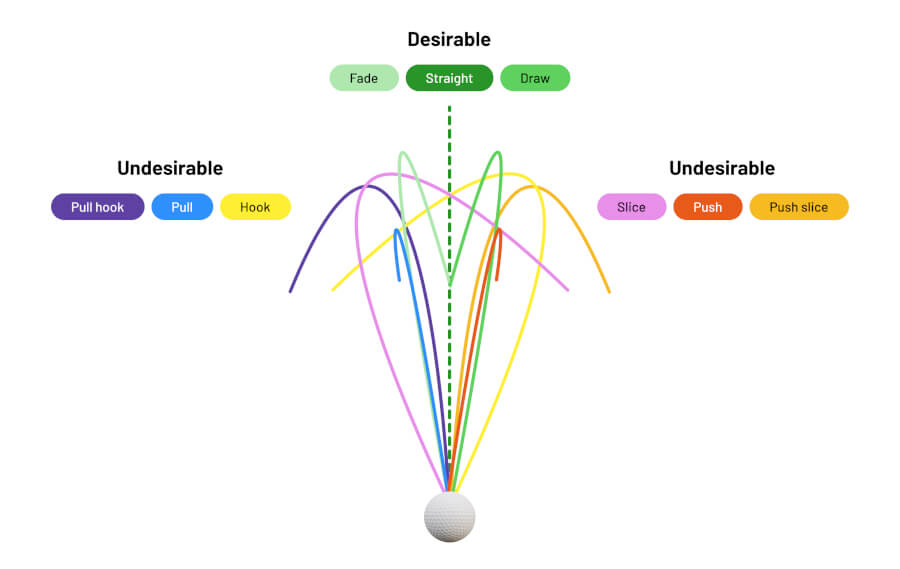Golf is a sport that requires precision and skill. One of the key factors that can greatly affect a golfer's performance is the spin of the golf ball. Understanding and harnessing the power of spin is crucial for achieving longer distances, better control, and overall improved results on the golf course. In this article, we will dive deep into the world of golf ball spin, specifically focusing on spin rate vs spin axis, and explore the importance of these two factors in the game of golf.
Understanding Golf Ball Spin
Before we delve into the intricacies of spin rate and spin axis, it's important to have a basic understanding of golf ball spin. When a golf ball is struck with a clubface, it starts to spin in the air due to the interaction between the club and the ball. This spin is responsible for various aspects of the ball's flight, including its trajectory, distance, and the way it reacts upon landing.

There are two primary types of spin involved in golf - backspin and sidespin. Backspin occurs when the golf ball rotates backwards during its flight, causing it to generate lift and stay in the air for a longer period of time. This backspin is what allows golfers to achieve greater distances and control in their shots. On the other hand, sidespin refers to the rotational movement of the ball around its axis that creates a curvature in its flight path. Sidespin can cause the ball to slice or hook, making it veer off its intended direction.
It's fascinating to note that the dimples on a golf ball play a crucial role in influencing its spin characteristics. These dimples create a thin layer of turbulent air around the ball as it moves through the atmosphere. This layer reduces drag, allowing the ball to travel further. Moreover, the dimples also help in optimizing the lift generated by backspin, contributing to the ball's overall flight stability and distance.
Another interesting aspect to consider is the impact of the golf club's grooves on spin. The design and condition of the grooves on the clubface can significantly affect the amount of backspin imparted on the ball. Clean, well-maintained grooves provide better grip on the ball, leading to increased spin rates and better control over shot shaping. Understanding how these factors interact can help golfers fine-tune their game and achieve desired outcomes on the course.
The Importance of Spin Rate in Golf
Spin rate is a key metric that measures how fast the golf ball rotates during its flight. It is usually measured in revolutions per minute (RPM). The spin rate of a golf ball has a direct impact on its trajectory and how it interacts with the air. A higher spin rate generally results in a higher ball flight, while a lower spin rate tends to produce a lower ball flight.
For golfers looking to maximize distance, finding the ideal spin rate is essential. Too much spin can cause the ball to balloon in the air, resulting in a lack of distance. Conversely, insufficient spin can lead to a low trajectory, causing the ball to roll excessively upon landing and sacrificing control.
Additionally, the spin rate of a golf ball also influences its stopping power on the greens. Shots with higher spin rates have a greater ability to stop quickly and hold the green, allowing golfers to target pins with precision and avoid potential hazards. On the other hand, shots with lower spin rates may struggle to hold the green and could lead to unfavorable outcomes.
It's important to note that spin rate is not solely determined by the clubface angle at impact but is also influenced by factors such as clubhead speed, angle of attack, and the characteristics of the golf ball itself. Golfers can adjust their spin rates by using different types of golf balls, each designed to produce varying levels of spin. Some golf balls are engineered to generate high spin rates for players who want more control over their shots, while others are designed for lower spin rates to help golfers achieve greater distance.
Professional golfers often work closely with equipment manufacturers and golf coaches to fine-tune their spin rates to suit their playing style and course conditions. By optimizing their spin rates, golfers can enhance their overall performance on the course, from maximizing distance off the tee to sticking approach shots close to the pin. Understanding the intricacies of spin rate and its impact on ball flight is crucial for golfers of all skill levels looking to improve their game.
Exploring Spin Axis and Its Impact on Ball Flight
Spin axis refers to the tilt or orientation of the golf ball's rotational axis as it moves through the air. It is often expressed in terms of a clock face, with 12 o'clock representing a vertical axis and 6 o'clock representing a horizontal axis. The spin axis plays a crucial role in determining the direction and curvature of the ball flight.
When a golf ball has a straight or vertical spin axis, it tends to travel in a straight line without any significant curvature. This is the ideal scenario for golfers aiming for accuracy and consistency. Conversely, when the spin axis is tilted or tilted to the side, it introduces sidespin into the equation, causing the ball to curve either left or right. This curving effect can be advantageous or detrimental depending on the situation and the golfer's intent.
Understanding spin axis allows golfers to control their shots and work their way around obstacles on the golf course. By consciously manipulating the spin axis, golfers can intentionally create draws or fades, shaping the ball flight to their advantage. This ability to shape shots based on the spin axis provides golfers with a versatile tool to navigate various course conditions and improve their overall performance.
Moreover, the spin axis of a golf ball can also influence its trajectory when faced with external factors such as wind and slope. For instance, a golfer facing a crosswind may adjust the spin axis to counteract the wind's effect, allowing the ball to maintain a more stable flight path. Similarly, on a downhill lie, understanding how the spin axis interacts with the slope can help golfers anticipate how the ball will behave upon impact.
Furthermore, professional golfers often utilize their knowledge of spin axis to execute advanced shot-making techniques. By manipulating the spin axis along with other factors such as clubface angle and swing path, skilled golfers can achieve precise shot shapes that meet the demands of challenging course layouts. This level of control over the spin axis not only showcases a player's expertise but also demonstrates the intricate science behind the art of golf.
Factors Affecting Spin Rate and Spin Axis
Several factors influence the spin rate and spin axis of a golf ball. Firstly, clubhead speed plays a significant role in determining both metrics. A faster clubhead speed tends to generate higher spin rates. This is because the faster the clubhead is moving, the more friction it creates with the golf ball, resulting in increased spin. Conversely, a slower clubhead speed will produce lower spin rates.
Similarly, the angle of attack, or how the club interacts with the ball at impact, affects the spin rate and spin axis. Golfers with a steeper angle of attack tend to produce higher spin rates, while a shallower angle of attack can result in a lower spin rate. The angle of attack refers to the direction in which the clubhead is moving relative to the ground at impact. A steeper angle of attack means the clubhead is descending more sharply, creating more friction and spin on the ball.
The type of golf ball used also impacts spin rate and spin axis. Golf balls with different constructions and designs perform differently in terms of spin characteristics. Some balls are specifically engineered to generate more spin, while others are designed for lower spin rates. For example, a ball with a soft cover material will typically produce more spin, as the softer material allows for greater friction between the clubface and the ball. On the other hand, a ball with a harder cover material will tend to produce less spin.
Additionally, the condition of the golf ball, such as its age and wear, can also influence spin rates and spin axis. As a golf ball gets older and more scuffed, its ability to generate spin may decrease. The dimples on the surface of the ball, which are designed to create lift and spin, can become worn and less effective over time. Therefore, it is important for golfers to regularly inspect and replace their golf balls to maintain optimal spin performance.
Lastly, the type of golf swing and the golfer's technique can affect spin rate and spin axis. Factors such as the angle of the clubface at impact, the path of the swing, and the quality of contact all play a role in determining the resulting spin rates and spin axis. A square clubface at impact will generally produce a straighter ball flight with less spin, while an open or closed clubface can introduce sidespin and affect the spin axis. The swing path, whether it is inside-out or outside-in, can also influence the spin axis and the shape of the shot.
In conclusion, understanding the concepts of spin rate and spin axis provides golfers with valuable insights into the dynamics of golf ball flight. By optimizing spin rates and manipulating spin axis, golfers can gain greater control over their shots and enhance their overall performance on the golf course. Advanced knowledge of these two factors allows golfers to unlock their full potential and achieve their desired results with every swing. So, the next time you step onto the golf course, take into consideration these factors and watch as your shots soar with precision and accuracy.
Need more help understanding your spin rate and spin axis? Rapsodo offers golf ball launch monitors like the MLM Mobile Launch Monitor or the MLM2PRO to help any player learn more about their spin rate and spin axis.














